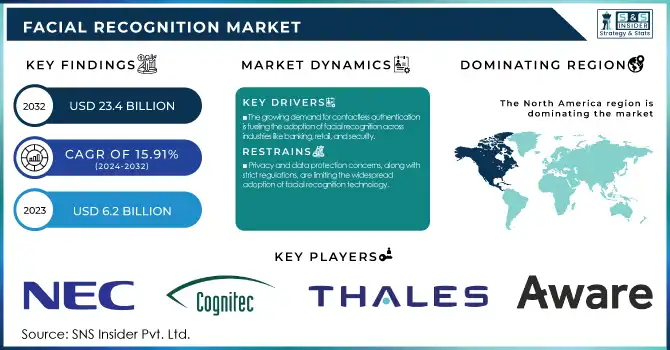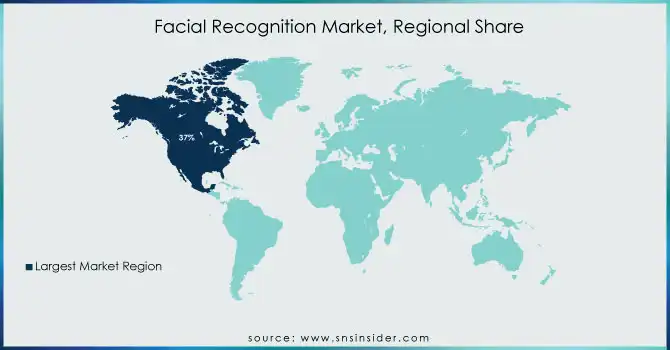Facial Recognition Market Size & Trends:
The Facial Recognition Market Size was valued at USD 6.2 Billion in 2023 and is expected to reach USD 23.4 Billion by 2032, growing at a CAGR of 15.91% from 2024-2032.

To get more information on Facial Recognition Market - Request Free Sample Report
The market is growing apace across sectors such as security, banking, and, retailing to a rapid adoption fueled by advancements in AI, growing network capabilities in geographical areas such as North America and Asia-Pacific increase system precision, while an increase in cyber-attack events from 2020-2023 creates apprehension regarding data integrity. Cloud-based facial recognition use cements their scalability and the possibility of authenticating remotely. The report consists of market segments by end-user industries, region, regulatory landscape, competitive analysis, AI and deep learning technology advancements, ethics and data privacy challenges, and key growth opportunities.
Facial Recognition Market Dynamics
Drivers:
-
The growing demand for contactless authentication is fueling the adoption of facial recognition across industries like banking, retail, and security.
Growing demand for seamless and secure authentication methods propelling the growth of the facial recognition market. Banking, retail, and government agencies all implement financial recognition for identity verification, access control, and prevention of fraud. With the stronger development of AI and deep learning, the accuracy of facial recognition has improved, so it is a preferred form of authentication compared to traditional password and fingerprint scanning. Face recognition provides an added layer of security at a time when online security is becoming a more pressing issue, and thus it has a rapidly growing demand in different applications.
Restraints:
-
Privacy and data protection concerns, along with strict regulations, are limiting the widespread adoption of facial recognition technology.
Increasing privacy and data security concerns are some of the major factors hampering the growth of the facial recognition market. Several governments and regulatory authorities have come up with strict guidelines on the collection, storage, and use of such data, to avoid any potential misuse of this sensitive data. Increasingly, the ethics of facial recognition, especially in surveillance and law enforcement. The growing number of data breaches and illegal exploitation of facial data have heightened these concerns. Consequently, stringent compliance requirements and legal uncertainties are hampering the adoption of facial recognition technology at scale in data privacy-sensitive regions.
Opportunities:
-
Integration with smart city initiatives is creating new growth avenues for facial recognition in public security, transportation, and urban management.
Increasing investments in smart city projects globally are expected to create a landscape of opportunity for the facial recognition market. Facial recognition for public security, traffic, and law enforcement applications is also increasingly being used by governments. This will be accompanied by the integration of AI-powered analytics, surveillance systems, and IoT devices, which will be used to promote urban safety and operational efficiency. To take various aspects of transportation to a smart level, facial recognition is now being used at airports, metro stations, and public transport hubs to improve passenger authentication. With the increasing technological investment in digital transformation and security infrastructure by cities, facial recognition will certainly be an integral part of cities of the future.
Challenges:
-
Bias and accuracy issues in AI-driven facial recognition systems raise concerns about misidentification and fairness, especially in security applications.
The key challenge in the facial recognition industry is the biased and accurate AI-based recognition system. Facial recognition algorithms tend to be biased by gender, ethnicity, and age, and such biased algorithms often misidentify people, which could also potentially lead to discrimination against vulnerable people. This has raised concerns, particularly in the area of policing and security applications. If used in the wrong way, it may yield inaccurate results, causing false positives or false negatives, thus jeopardizing the credibility and reliability of the technology. To tackle those biases, AI models need to be constantly improved, preferably built with diverse training datasets and thorough algorithm transparency so that the algorithms can be used accurately and fairly in the real world.
Facial Recognition Market Segmentation Overview
By Technology
In 2023, the 3D facial recognition segment dominated the market and accounted for the largest share of more than 42% of the market. 3D systems typically capture subtle variations in the contours of a person’s face, leading to more exact results and a decreased risk of susceptibility to spoofing attacks, it's generally used for high-security purposes. The adoption of 3D facial recognition for biometric authentication and fraud prevention in sectors such as BFSI, government, and defense is fueling growth. As AI-based facial mapping and depth-sensing technologies continue to improve, 3D facial recognition solutions are poised to filter into a variety of industry applications.
The Facial Analytics segment is expected to grow at the fastest CAGR during the period 2024-2032 owing to its rising adoption across retail, marketing & healthcare domains. Using this technology, companies can identify customer emotions, demographics, and engagement levels which brands can use to improve the overall customer experience and targeted marketing methods. AI-powered video surveillance with facial analytics is making waves as a security application by allowing for the detection of anomalies and behavior analysis in real time.
By Application
Access Control dominated the market and accounted for a revenue share of more than 38% in 2023 as it is widely adopted in corporate offices, banks, and other secured areas. AI-driven facial recognition solutions are also replacing traditional keycard-based access systems at a faster rate due to an increasing demand for improved security and operational efficiency and seamless user authentication. Rising demand for advanced access control solutions is mainly expected to be driven by the increasing use of facial recognition in industries such as BFSI, IT, and government for secure login processes and restricted area access.
The Security and Surveillance segment is expected to achieve the fastest CAGR during the period between 2024 and 2032, owing to the increasing use of AI-enabled facial recognition technology for various related tasks, including homeland security, law enforcement, border security, and public safety. Authorities globally are using massive networks of facial recognition to prevent crime and identify suspects. Increasing integration of AI with video surveillance systems is improving real-time threat detection, which in turn is expected to spur demand for video surveillance systems in this segment.
By End-Use
The Retail & E-commerce segment dominated the market and held the highest market share in 2023. Facial recognition can help to deliver personalized customer experience, fraud prevention, and even automate payment solutions. Facial Analytics is being increasingly implemented by retailers for customer preferences and engagement tracking and then fine-tuning their target marketing campaigns. Retail demand for facial recognition solutions is further stoked by self-checkout and cashier-less stores.
The Healthcare segment is expected to register the fastest CAGR during the forecast period, owing to the rising use and initiatives to adopt facial recognition in patient identification, and remote consultations, and to fetch medical records securely. As the need for safe, secure handling of sensitive data rises, hospitals and telemedicine providers integrate biometric authentication to deliver optimal patient safety, minimize medical fraud, and speed up administrative actions.
Facial Recognition Market Regional Landscape
North America region dominated the market and held the highest market share of more than 37% in the Facial Recognition market in 2023 owing to the presence of a great number of technology giants, rising investments in AI research, and its high acceptance rate in government as well as commercial sectors. The American world is a pioneer, in using facial recognition at airports, police forces, and banks. The region will continue to grow due to strict security regulations and continual improvements in biometric technology.
The Asia-Pacific is projected to be the fastest growth, driven by urbanization, smart city projects, and an increase in government investments to purchase biometric-related security solutions. Many nations, including China, India, and Japan, are already using AI-based facial recognition for surveillance, national security, and digital identity initiatives. In this region, facial recognition integration in the banking and retail sectors will further stimulate market growth.

Get Customized Report as per Your Business Requirement - Enquiry Now
Key Players
The major key companies of Facial Recognition Systems are
-
NEC Corporation – NeoFace
-
Cognitec Systems GmbH – FaceVACS
-
Thales Group – Cogent Face Recognition
-
Aware, Inc. – Knomi
-
FaceFirst, Inc. – FaceFirst Platform
-
IDEMIA – MorphoFace
-
Microsoft Corporation – Azure Face API
-
Amazon Web Services (AWS) – Amazon Rekognition
-
Google LLC – Google Cloud Vision AI
-
IBM Corporation – IBM Watson Visual Recognition
-
Clearview AI – Clearview Facial Recognition Database
-
AnyVision – Better Tomorrow Platform
-
TrueFace – TrueFace AI
-
Herta Security – BioSurveillance NEXT
-
Vintra Inc. – Vintra IQ
Recent Developments
-
In November 2024, Apple introduced a new Face ID authentication option in iOS 18.2 Beta 2, allowing users to trust computers using facial recognition instead of entering their device passcode.
-
In February 2024, NEC's face recognition technology was ranked the world's most accurate in a benchmark test conducted by the U.S. National Institute of Standards and Technology.
| Report Attributes | Details |
|---|---|
| Market Size in 2023 | USD 6.2 Billion |
| Market Size by 2032 | USD 23.4 Billion |
| CAGR | CAGR of 15.91% From 2024 to 2032 |
| Base Year | 2023 |
| Forecast Period | 2024-2032 |
| Historical Data | 2020-2022 |
| Report Scope & Coverage | Market Size, Segments Analysis, Competitive Landscape, Regional Analysis, DROC & SWOT Analysis, Forecast Outlook |
| Key Segments | • By Technology (2D, 3D, Facial Analytics) • By Application (Emotion Recognition, Attendance Tracking and Monitoring, Access Control, Security & Surveillance, Others) • By End - Use (Retail & E-commerce, Media & Entertainment, BFSI, Automobile & Transportation, Telecom & IT, Government, Healthcare, Others) |
| Regional Analysis/Coverage | North America (US, Canada, Mexico), Europe (Eastern Europe [Poland, Romania, Hungary, Turkey, Rest of Eastern Europe] Western Europe] Germany, France, UK, Italy, Spain, Netherlands, Switzerland, Austria, Rest of Western Europe]), Asia Pacific (China, India, Japan, South Korea, Vietnam, Singapore, Australia, Rest of Asia Pacific), Middle East & Africa (Middle East [UAE, Egypt, Saudi Arabia, Qatar, Rest of Middle East], Africa [Nigeria, South Africa, Rest of Africa], Latin America (Brazil, Argentina, Colombia, Rest of Latin America) |
| Company Profiles | NEC Corporation, Cognitec Systems GmbH, Thales Group, Aware, Inc., FaceFirst, Inc., IDEMIA, Microsoft Corporation, Amazon Web Services (AWS), Google LLC, IBM Corporation, Clearview AI, AnyVision, TrueFace, Herta Security, Vintra Inc. |

